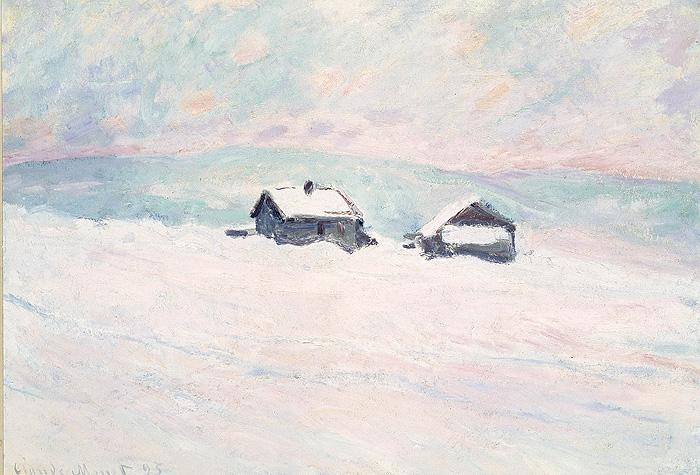
Other areas /
Google Ads
When Claude Monet Did NorwayProbably few people are aware that both Claude Monet and Paul Gauguin spent time in Scandinavia. |
SUBSCRIBE SEND AS EMAIL |

|
|
| 1 | |
|
The French pioneers of avant-garde art who developed Impressionism during the 1880s and ’90s left their mark throughout all of Europe, including the Scandinavian countries. Numerous Nordic artists made the long trek to Paris or Bretagne to study with the French masters, and Impressionist paintings were also exhibited during the 1990s in several Nordic cities.
Few people are probably aware, however, that both Claude Monet and Paul Gauguin spent time in Scandinavia. Claude Monet, best known for his magical depiction of water lilies, spent the winter of 1885 in Norway painting snowbound scenes of farmhouses in different kinds of lighting and winter weather. Monet’s Norwegian landscapes are some of the most striking works contained in the exhibition “Impressionism and the North,” hosted this fall by Sweden’s National Museum of Fine Arts. The cultural interchange during this period was a two-way street. Scandinavia was in fashion in France during 1890s due to the popularity of literary lions such as Strindberg and Ibsen, and composers including Edvard Grieg. Monet came to Norway mainly to experience snow, but the adventurous Frenchman initially found it to be too much of a good thing: “This country is undoubtedly infinitely more beautiful without snow, or at least when there isn’t so much of it,” he wrote. He was also frustrated in his effort to find beautiful landscapes by his inability to ski. While in Norway, Monet met the Norwegian painter Fritz Thaulow as well as Sweden’s own Prince Eugen, whose paintings are today exhibited at Waldemarsudde Museum in Stockholm. Similarly, post-Impressionist Paul Gauguin, who is best known for his paintings from Tahiti, also spent a half-year in Copenhagen. He followed his Danish-born wife Mette and their four children to Copenhagen in 1884-85. “Copenhagen is certainly picturesque, and there are characteristic, pretty things to paint where I am staying. It is now 10 degrees cold and horses are pulling sleds through the streets,” Gauguin wrote shortly before he arrived in Denmark in November 1884. But the French painter’s enthusiasm for Copenhagen was short-lived, and he moved back to France seven months later, and thereafter onward to Tahiti. Scandinavian Impressionists One result of Gauguin’s stay in Denmark, however, was a friendship with the Danish painter Theodor Philipsen, who enjoyed the great advantage of speaking French. Philipsen’s vibrant paintings of nature capture an ephemeral moment, creating a delicate sense of movement. Departing from traditional motifs for Impressionist-like street life, picnics or landscapes, Philipsen often ventured into the barn and field to portray cattle and horses. “Many Nordic painters made something personal out of the impressions they received. They didn’t just make copies of what they saw, but tried to develop a personal, or even a Scandinavian touch,” observes Torsten Gunnarsson, the National Museum’s director of collections, who organized the current exhibit. Among Swedish painters, Anders Zorn is the one who seems to have most enthusiastically picked up the Impressionist mantle. Zorn was also acquainted with several of the French masters, such as Renoir and Degas. Less familiar outside Scandinavia are the works of Karl Nordström, Nils Kreuger and Ivan Agueli, whose paintings sometimes seem imbued with the golden light of Gauguin. One is somewhat surprised to see Norway’s Edvard Munch represented in the Stockholm exhibit, but he too experimented with Impressionism on his way to a more personal style in touch with the anguish of his soul. Among the Finnish artists represented in the “Impressionism and the North” exhibit, the painter Helene Schjefbeck stands out as a gem who deserves far greater recognition. The National Museum’s ambitious exhibit includes some 70 French and 100 Nordic paintings and demonstrates how revolutionary artistic ideas were assimilated and transformed in unexpected ways in Scandinavia. Written by David Bartal Note: “Impressionism and the North” continues in Stockholm until January 19; it will then continue in an abridged form at the National Gallery of Copenhagen, where it will run from February 22 to May 25. |
Other articles on Art / A Look at Three-Dimensional Scandinavian Art Bedroom politics a century ago Mirror of Nature Scandinavian Art in New York Cirkus Cirkör gets under your skin East Meets West Queens kids visit Ribe, Denmark Scandinavian art in New York Immigrant Chefs in America Scandinavian at the International Contemporary Furniture Fair in New York
|
800 827 9333 © Copyright Nordic Reach 2008